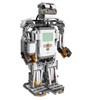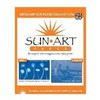Scientifically Speaking: A Holiday Wish List
If you're making lists and checking them twice this holiday season, make sure you put on your science cap as you think through what you really want! Well, that would be our suggestion. There may be many things on your list, but sometimes the best gifts to receive are ones that you can use over and over and over again, ones that will inspire and challenge you, and ones that let you explore, discover, create, and, yes, play. Plus, we know that moms and dads, aunts and uncles, and especially grandparents, like to give things they know are good for you (like socks) or educational (like a new dictionary).
Many Science Buddies Project Ideas use kits or tools that can be fun to explore, can be worked into a school project, and can be used again for other experiments as well. It can't hurt to note on your list that what you're asking for could become the seed of your next science fair project—or could launch you on a new career path! (Psst... mom... dad... did you hear?)
We think science lurks in just about everything, so there are plenty of things you might ask for, but we've looked through our Project Ideas and pulled our Top 12 science gizmos or tools--based on sheer science fun (from our perspective). To help you make a convincing appeal on your list, we're giving you the goods here: a relevant science project and a set of terminology you can use when writing up your list.
- Frightened Grasshopper Kit: Nano-style bugs and bots of all kinds can be fun, especially when they seem to have a mind of their own! Explore solar power and electronics as you build your own solar-powered insect. No 'pet-walking' required! Want to teach your light-loving bot a trick or two? Check out this project idea to figure out how much light it needs (Difficulty: 3-4). Terms to use: radiant energy , electrical energy, solar panel, kinetic energy , wattage.
- Picoboard: If you love video gaming and especially dig cool features that depend on user input
 (like blowing the notes to play the flute in Zelda on the Nintendo DS), you can have fun building your own apps in the free Scratch programming environment. When you hook a Picoboard to your application, you've got the ability to use sound, motion, light, resistance, and other input values. For a project that can launch you into PicoBoard programming, look at Pinwheel Magic: Take a Spin with Animation (Difficulty: 5). Terms to use: algorithm, program, flowchart, sensors, user input.
(like blowing the notes to play the flute in Zelda on the Nintendo DS), you can have fun building your own apps in the free Scratch programming environment. When you hook a Picoboard to your application, you've got the ability to use sound, motion, light, resistance, and other input values. For a project that can launch you into PicoBoard programming, look at Pinwheel Magic: Take a Spin with Animation (Difficulty: 5). Terms to use: algorithm, program, flowchart, sensors, user input. 
Tie Dye supplies: Tie-dying t-shirts or fabric to make scarves and pillows lets you transform ordinary fabric into something that shows off your own unique personality and color sense. You can explore fiber-reactive dyes and how they work differently with different types of fabric in the How to Make the Boldest, Brightest Tie-Dye! project (Difficulty: 5). Terms to use: natural fiber, synthetic fiber, cellulose, protein, molecule, saturation.
- Papyrus paper kit: Making your own "papyrus" will give your art a hefty combo of science and history. If you've tried papermaking before (deckle ring a bell?), you can explore the ways in which making a sheet of papyrus differs, but you'll also be exploring materials science. The Pounding Papyrus: How Ancient Egyptians Made the World's First Paper project lets you examine differences in ancient and modern paper making techniques (Difficulty: 6). In the end, you'll have cool paper to add to your scrapbook or next bookbinding project. Terms to use: Ancient Egypt, Cyperus papyrus plant, bamboo, cuneiform tablet, pulp, tensile strength, tensile force.
- LEGO Mindstorms:
Take your LEGO building to new heights when you add in the programmability of LEGO Mindstorms. You can get started exploring the world of robotics in the Go, Gadget, Go! Building Robots with LEGO® Mindstorms® project (Difficulty: 6). But that's just the beginning. There are many great guides that can help you build cool mechanical tools—from LEGO. If you've got a parent always complaining about LEGO begin underfoot, you might mention that you could build a LEGO picker-upper—or a brick sorter! (Difficulty: 7). Terms to use: robotics, programming, electric engineering, engineering method. - Remote-Control Helicopter: Whether it flies indoors or outdoors, RC vehicles can be your key to aerodynamic—and electronics— investigation. Once you're done sending it buzzing and hovering around a sibling (or after the family pet), you can settle down to some hard-core aero-exploration in Helicopter Liftoff: How Does the Speed of the Rotor Affect the Amount of Lift? (Difficulty: 7). Terms to use: blade, rotor, airfoil, lift, leading edge, angle of attack, digital tachometer, revolutions per minute (rpm).
- XPULT catapult: Launching balls through the living room doesn't get much more fun!
 But there's both mechanical engineering and physics at hand as you work to achieve the perfect shot. As you experiment with the XPULT catapult in a project like Bombs Away! A Ping Pong Catapult, you'll explore trajectory and launch and pullback angles (Difficulty: 4-5). Terms to use: basic physics, potential and kinetic energy, ballistics, resistance, friction.
But there's both mechanical engineering and physics at hand as you work to achieve the perfect shot. As you experiment with the XPULT catapult in a project like Bombs Away! A Ping Pong Catapult, you'll explore trajectory and launch and pullback angles (Difficulty: 4-5). Terms to use: basic physics, potential and kinetic energy, ballistics, resistance, friction.
- Sun Print Paper: The days of December may not invite you to spend much time outside, but with a pack of sun print paper, you'll be watching for the first sunny day and the chance to explore photograms. In the Colorful Chemistry Creations: Make Your Own Sun Print with Color and Sunlight! project, you can investigate how effective various colors are when it comes to filtering UV light (Difficulty: 3-5). You can also pick up a bit of photography history in our blog entry on sun prints. Terms to use: light-sensitive, Berlin green, water-soluble, chemical reaction, Prussian blue, insoluble, light filter.
- Telescope: What better way to put the skies in perspective at varying times of the year than with your own telescope? Like a SLR or DSLR camera, a telescope is something your whole family can use—time and again. What you explore or investigate through the lens may be galactic in scale, but you can get started with the Similar Triangles: Using Parallax to Measure Distance project (Difficulty: 7). Don't forget, the Science Buddies—Lick Observatory Astronomy Contest is underway! Terms to use: motion parallax, arc minutes, arc seconds.
We hope you have fun—and get cool science and engineering "toys" you can really use. Who knows what you might discover? Or invent? Or uncover?
(Editorial Note: Links to Amazon.com for some of the above products are provided for additional information. Science Buddies does not sell kits or supplies directly. Any/all purchases are between you and the vendor you select.)
Categories:
You Might Also Enjoy These Related Posts:
- Plastics and Earth Day - Science Projects
- Arduino Science Projects and Physical Computing
- 10+ Robotics Projects with the BlueBot Kit
- 5 STEM Activities with Marshmallow Peeps
- March Madness Basketball Science Projects: Sports Science Experiments
- Women in STEM! More than 60 Scientists and Engineers for Women's History Month
- Explore Artificial Intelligence and Machine Learning with Student AI Projects
- 10 Reasons to Do the Rubber Band Car Engineering Challenge












